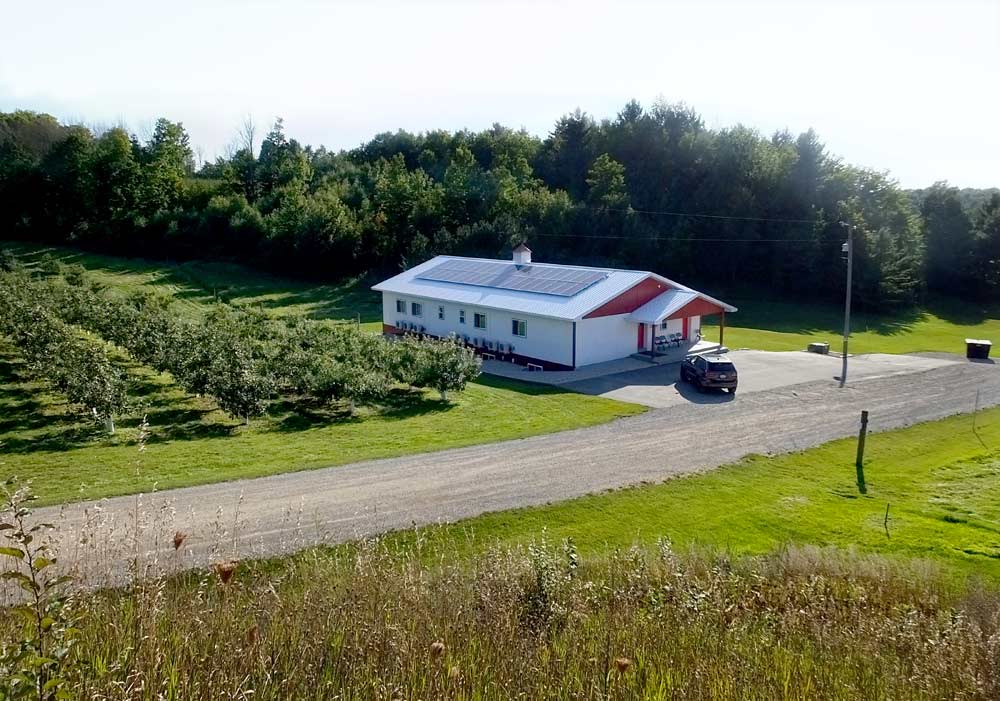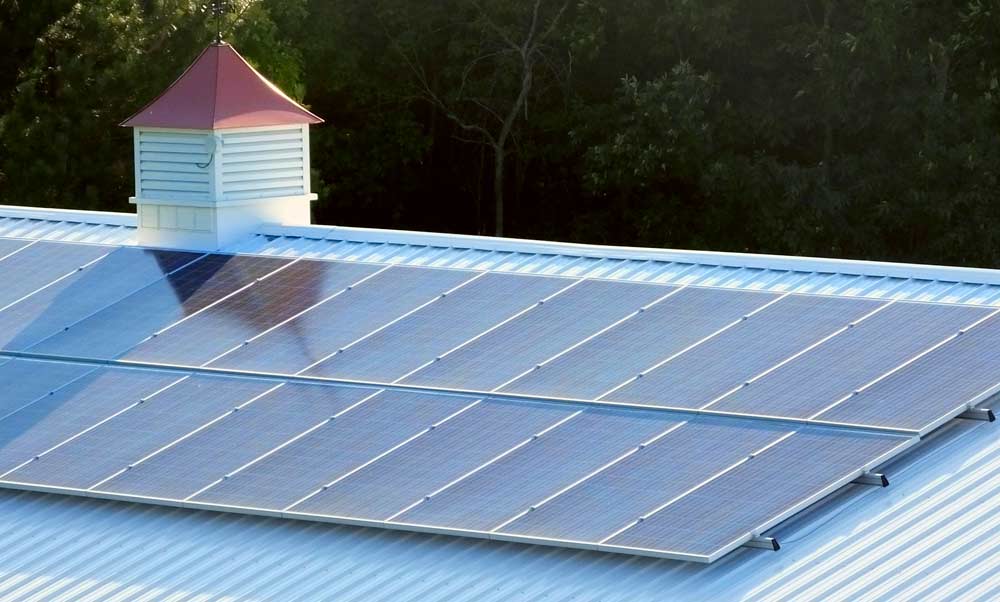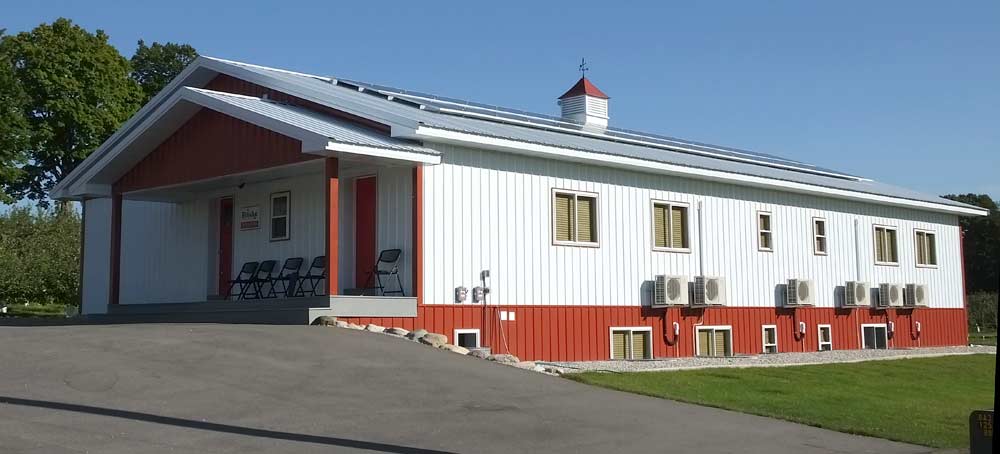
The new bunkhouse at Friske Orchards of Charlevoix, Michigan, provides comfortable accommodations for up to 50 seasonal employees. (Photo by Leslie Mertz.)
When Richard Friske and his adult children resolved to replace the well-used labor housing on their 200-acre Michigan orchard, they decided to take advantage of the latest in building techniques and technologies, including energy efficiencies.
The result is a new, steel-sided, fully insulated and solar-powered structure that has room for up to 50 seasonal employees.
The scale of the project and the extent of its energy-efficiency measures prompted a local energy expert to nominate the orchard for a 2017 Governor’s Energy Excellence Award. In October, Michigan Gov. Rick Snyder announced award winners in eight separate categories, including “Best Agricultural Project,” which went to Friske Orchards.
A couple of things prompted the Friske family to upgrade from the trailers that it had used for many years. One nudge came when the orchard transitioned to the H-2A program, which requires basic lodging standards for workers.
“But the main reason was that the labor housing was an inconsistency in our whole operation,” said Richard Friske, who runs the farm and associated retail business with his daughter and two sons. “We have first-class everything, but we had those old mobile homes. Although the camp was always neat and clean — and we worked hard and spent a lot of money to keep up the trailers, including replacing doors and windows almost every year — it was a losing battle. So, we decided we’d invest in labor housing and make it a priority.”

The roof is covered with solar panels, which provide more than enough power during the summer months. (Photo by Leslie Mertz)
Going high-tech
Although it would have been easier and much less expensive to simply put in new mobile homes, they didn’t consider that as an option.
“We don’t have the most intense heat here in northern Michigan, but I always felt terrible when the workers would labor so hard in the heat and then go into those mobile homes, which on a hot summer day can be like a hot tin can,” Friske said.
That led to discussions about a new bunkhouse, and the family quickly decided to take advantage of the latest in building techniques, technologies and energy efficiencies.
They settled on a two-story, 5,000-square-foot building with insulated concrete walls (poured concrete inside foam blocks) and a heavily insulated ceiling, which go a long way toward keeping the building cool in the summer and warm in the winter.
They also added a 20-kilowatt solar power system, including solar panels that cover much of the roof; high-efficiency heat pumps in each room; on-demand hot-water tanks; LED lighting; and EnergyStar appliances.
In all, the bunkhouse has mainly three-person, dormitory-style rooms on the first floor, along with a shared kitchen, laundry and bathroom/shower. Four two-bedroom apartments fill the second floor, and an additional two-bedroom apartment is located in the basement.
Building and outfitting the bunkhouse totaled approximately $500,000. Other than about $40,000 that came in the form of a 30 percent federal tax credit on the solar system and a few small energy-optimization rebates offered by the electric company, the orchard paid for the building out of pocket with a little help from private financing.
“It was expensive, but it’s just very important to us as a family to work in a place that is clean, neat and sharp. We live here and we work here,” Friske said, pointing through his office window to his house across the road. “There’s just no more important place to us than our home and our farm, and we want to do things right.”

A 2017 Governor’s Energy Excellence Award, one of only eight awarded, recognized Friske Orchards’ 5,000-square-foot bunkhouse for its highly efficient design and energy-saving features. These include insulated concrete walls, a heavily insulated ceiling, and 14 high-efficiency heat pumps (six shown here). Photo by Leslie Mertz
Happy owners and workers
Construction of the new bunkhouse was completed in 2016, and energy savings have been rolling in ever since. “I didn’t really analyze energy costs and figure out the payback ahead of time, like someone with an accounting background might, but we were just certain that it would pay for itself in the long run,” Friske said.
They were right. When the building was unoccupied over the winter, the heat pumps were sufficient to heat the entire bunkhouse to 70 degrees and at a cost of no more than $100 a month, quite a reduction from the $500-per-month heating bill for each trailer, he said.
And during this past summer and fall when 16 male laborers occupied the first level and six female workers lived in the second-level apartments, the solar system produced excess energy, so it sent more into the electric grid than it used and the electric bill showed a credit.
The new building offers excellent accommodations for the workers, said farm manager Benito Vasquez. “I’ve been working in the area for 33 years. I’ve managed facilities processing cherries, I’ve dealt with many growers, I’ve visited most of the migrant housing, and this is the best I’ve ever seen.
There’s nothing close to what we have here, to what Richard has built,” he said. “In fact, we just had the recruiter come up here all the way from Mexico (the H-2A workers are from Durango, Mexico) and he saw the facility. He was so impressed.”
Son Richard Friske III, 24, oversees the building, making sure everything remains in good condition and the workers are following the basic residential guidelines to keep it clean.
“Most of our guys have been very respectful and have kept it nice, but we do a weekly inspection to check on things and give a little feedback if something is off. It’s been worth the effort,” he said. “Hopefully, this bunkhouse will be here for as long as I’m doing this, and, if that’s the case, it’ll be worth the investment.” •
—by Leslie Mertz






Leave A Comment